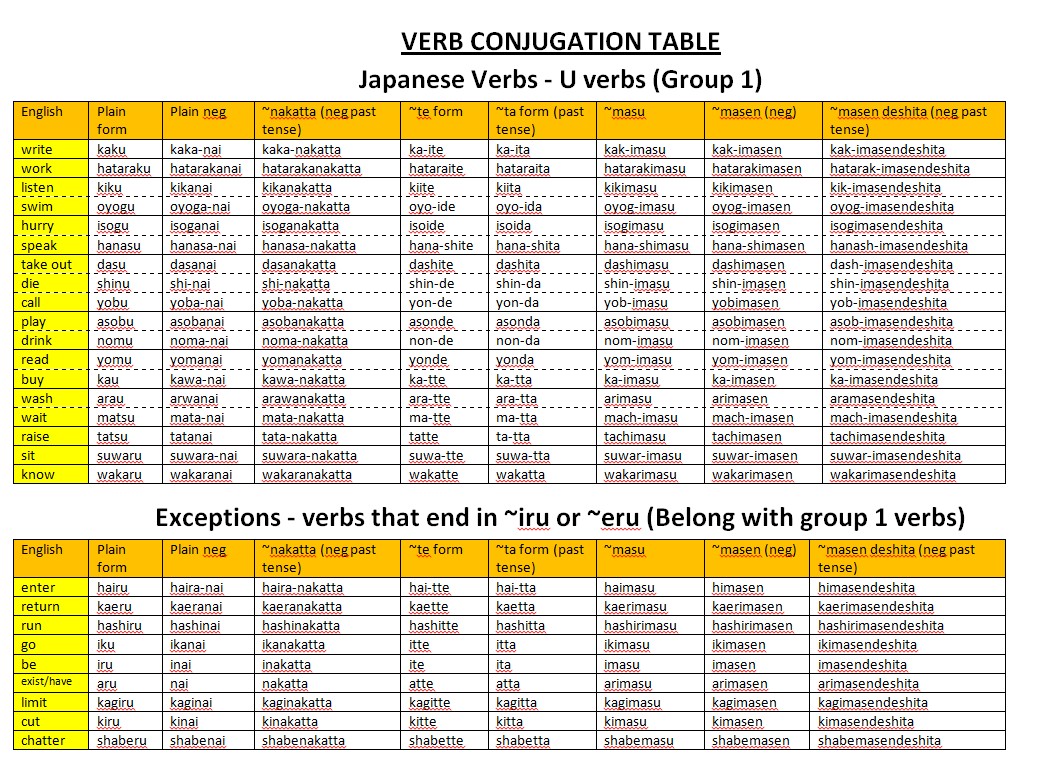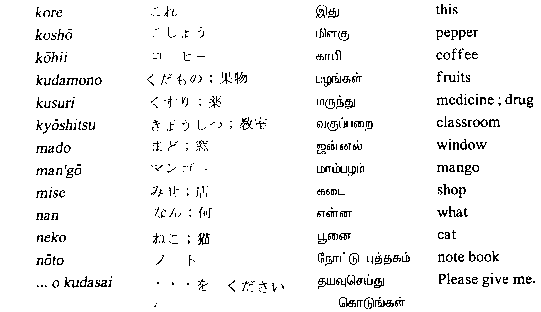Online conjugation: the best way to learn how to conjugate an English verb. Write the infinitive and the English conjugator will display forms in past tense, participle. OLD JAPANESE VERBALS Bjarke Frellesvig 1. Old Japanese is a dead language, a closed and limited text corpus. It is not surprising that will unambiguously identify the conjugation class of the verb in the majority of cases; in particular, this serves to distinguish Yodan from Nidan verbs. Do you know what Japanese Verb Forms to use when you speak (or write) in Japanese as an adult? What Japanese Verb Forms to Use Conjugation Chart. By YukoSensei on December 3, 2017 0. Do you know what Japanese verb forms to use when you are speaking (or writing) in Japanese? The Japanese Verb List (14 pages, PDF). The only site on the web featuring Japanese verb conjugation pictures of alien monsters. Also featuring the Ultra Handy Kanji database and tester, and over 180, 000 example sentences with sound English: Aeron Buchanan's Japanese Verb Chart: a concise summary of Japanese verb conjugation, handily formatted to fit onto one sheet of A4. Also includes irregulars, adjectives and confusing verbs. Also includes irregulars, adjectives and confusing verbs. Japanese verbs are roughly divided into three groups according to their dictionary form (basic form). The basic form of 'Group 1' verbs end with u. This is the formal form and it is suitable in a wide range of circumstances. The part of the verb without masu, is the stem. In Japanese, verbs are not affected by their subject. verb conjugations japanese teaching ideas list landing pg smile nihongo academy math worksheet french sheet print tenses amb verbs pdf wikibooks 26 awesome english. In this lesson, you will learn how to conjugate Japanese verbs in the present tense, past tense, present negative, and past negative. If you are not familiar with verbs yet, read Japanese Verb Groups first. Then, learn The te form, which is a very useful form of the Japanese verb. The Dictionary or Basic Form of Japanese Verbs Usage of Japanese Verbs A dictionary for foreign learners of Japanese Language Created by: Ei Cohen Electronically published by: Personal Oce Telintalk Tokyo Japan Revised Edition: June 2010. JOBUN (Japanese Preface) Jobun I Hissha ga, kanari nenrei ga takaku natte kara, eigo igai no gaikokugo wo manabi. Japanese verbs are categorized into uverbs and ruverbs. However, they can be further subdivided based on the conjugation patterns. In addition, there are some exceptions besides and. Japanese verb conjugation (cheat sheet) Philip Seifi Our cheat sheets have been some of the most popular posts on the blog for years, and we love receiving feedback and how they have been used, where in the world they are found, and teachers who swear by them. Japanese verb conjugation is fairly simple. The plain form of all verbs ends in u. There are very few irregular verbs, and this page contains a comprehensive list of their conjugations. In modern Japanese, there are no verbs ending in zu, fu, pu, or yu. There is only one verb ending in nu, shinu, to die. Conjugation of verbs, adjectives, and nouns! Nihongo Web Grammar Practice Sheets for Japanese 1 After completing the five Core Modules, you will take a midterm that evaluates your ability to use the basic grammar content of JA 101. Go Here for the Quick Adjectivehowto. The verb generally comes at the end of the sentence in the Japanese language. Because Japanese's sentences often omit the subject, the verb is probably the most important part in understanding the sentence. The following are exercises for verbadjective conjugations introduced in the Dialogue Grammar section. Enter the appropriate conjugation form of each given verbadjective. Japanese Verbs Chart Download as PDF File (. Scribd is the world's largest social reading and publishing site. Search Search meaning masuform Dictionary form taform naiform nakatta teform meet aimasu au atta awanai awanakatta atte be have arimasu aru atta nai nakatta atte Contents 1 Introduction 11 1. English Verb Tenses: An informal but extensive reference for ESL students, the good folks who teach them, the idly curious, and the linguistically perplexed by explain some points about verb tenses that you wont find in other grammar books. This book CANNOT take the place of a good ESL class. MLC Meguro Language Center 121 verbs (for JLPT N5) 1 Present Positive Dictionary form Present Negative form All forms of a verb are derived from the root form of a verb. If it is 'ru' it is easy to conjugate; otherwise, there is a set of rules described somewhat in the below table. Grammar: JLPT N5 Japanese verb conjugation Verb groups. Click on the image to download the PDF. Now, let's check if you can guess the group of any verb! ) Here is the conjugation chart for the TE form of group 1 verbs. We will now learn the three main categories of verbs, which will allow us to define conjugation rules. Before learning about verbs, there is one important thing to keep in mind. A grammatically complete sentence requires a verb only (including stateofbeing). Using Verb Bases Now that you know about 30 Japanese verbs and can conjugate them, I'll show you what you can do with those verb bases. You may want to regularly refer to Lesson 6 and Lesson 7 while learning these. The following chart applies to all Japanese verbs unless otherwise noted. Do you know the Easy Japanese website? NHK WORLD RADIO JAPAN also provides a variety of useful online content for the lessons free of charge. Please access and enjoy learning. Three Verb Groups in Japanese (p. 3 4 of Additional Notes for Lesson 3 Part 1) 8 Conjugation Rule Present Long Form (p. 4 5 of Additional Notes for Lesson 3 Part 1) 11 Affirmative Basic Sentence Structure with Verbs in Japanese 3 English: Mary watches TV. This chart lists the possible ways to conjugate verbs. Base 3 is the form that verbs are in when you read them in the dictionary. These verbs have five changes that follow the order of the Japanese vowels (i. the characters for that section of the hiragana chart), hence the name Godan (meaning 5 levels or steps), and then the te and ta forms that are common to all verbs. Click to view conjugation table Japanese Grammar Verbs. All about Japanese Verbs The different verb types of Japanese u verbs iru verbs eru verbs; irregular verbs; Japanese Verb Grammar Forms. The plain form of Japanese verbs; The masu form of Japanese verbs; The te form of. Tobberoth Wrote: When I was a beginner and needed to check conjugation tables from time to time, I relied on You can get an automatic conjugation table for any verb. You can get an automatic conjugation table for any verb. JOSHU is a portal for those who study Japanese language (Nihongo) and writing (Kanji) Learn how to say in Japanese makelet someone do something with this short video! Download the Japanese verb conjugation chart and learn how to use Japanes Skip navigation JAPANESE VERB CHART v2. 7 AERON BUCHANAN'S speaker's nonspeaker's vb. Japanese verb conjugation is the same for all subjects, first person (I, we), Aeron Buchanan's Japanese Verb Chart, a concise summary of all Japanese verb conjugations on one sheet of A4; JLearn. net, an online Japanese dictionary that accepts conjugated terms and returns the root verb All verbs to pass the JLPT N5. This is the list of all verbs you need to know in order to pass the JLPT N5. Click on the Share button at the end of the article and press the printer symbol in order to change to a printer friendly version. Japanese Verbs and Conjugation This is an introduction to Japanese verbs and conjugation, and provides the background for Part 2 of the Beginning Lessons. This lesson doesn't require you to have read anything else in Part 1, but the rest of Part 2 assumes that you are familiar with most of Part 1. Japanese Verb Conjugator Japanese () is spoken by over 120 million people in Japan. The Japanese language is written with a combination of three scripts: Chinese characters called kanji, and two syllabic scripts hiragana and katakana. japanese verb conjugation PDF: part1 only(this. 'to chart' conjugation English verbs conjugated in all tenses with the bab. The causative verb belongs to Group 2 and it has the masu form and the plain form The causative verbs also have the passive form. Group 1 verbs have two causative passive forms, a long form and short form, but ( ) ending verbs of Group 1, and Group 2 and Group 3 verbs have only a long form. When it comes to learning the Japanese Verbs, there is good news, unlike English or most European language, Japanese verb conjugation is the same for all subjects, first person (I, we), second person (thou, you) and third person (hesheit and they), singular and plural. The plain form of all verbs ends in u. There are very few irregular verbs, but if you master the. Basically, all verbs and adjectives consist of two parts: A word stem (the part that remains consistent); A word ending (the part that gets conjugated); In the dictionary, all word endings are which must be conjugated according to use..











